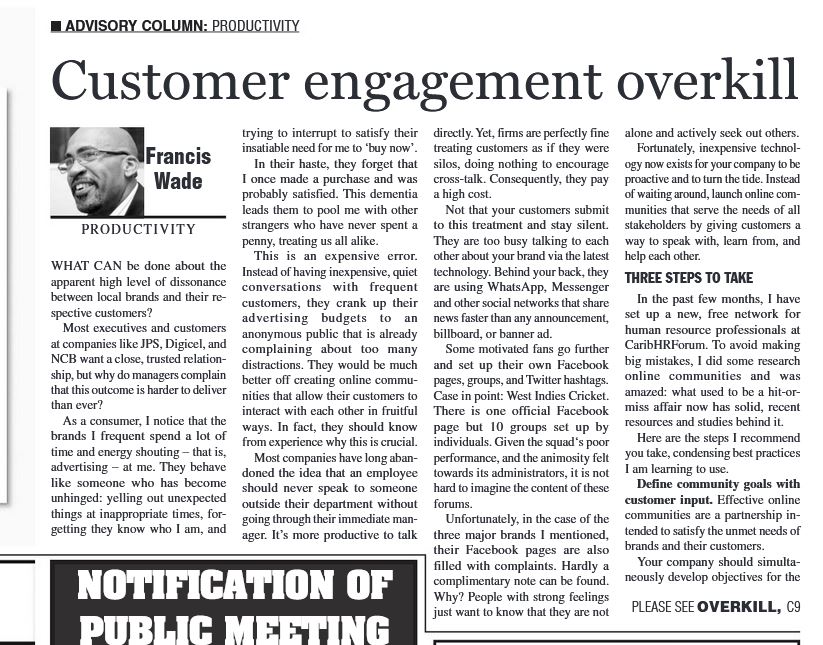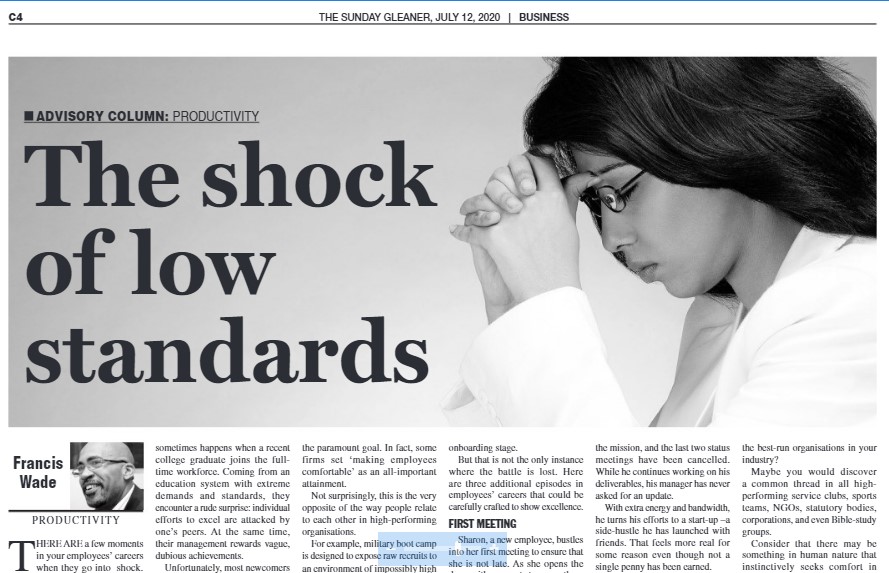What can be done about the apparent high level of dissonance between local brands and their respective customers? Most executives and customers at companies like JPS, Digicel and NCB want a close, trusted relationship, but why do managers complain that this outcome is harder to deliver than ever?
As a consumer, I notice that the brands I frequent spend a lot of time and energy shouting (i.e. advertising) at me. They behave like someone who has become unhinged: yelling out unexpected things at inappropriate times, forgetting they know who I am and trying to interrupt to satisfy their insatiable need for me to “Buy Now.”
In their haste they forget that I once made a purchase and was probably satisfied. This dementia leads them to pool me with other strangers who have never spent a penny, treating us all alike.
This is an expensive error. Instead of having inexpensive, quiet conversations with frequent customers, they crank up their advertising budgets to an anonymous public that’s already complaining about too many distractions. They’d be much better off creating online communities that allow their customers to interact with each other in fruitful ways. In fact, they should know from experience why this is crucial.
Most companies have long abandoned the idea that an employee should never speak to someone outside their department without going through their immediate manager. It’s more productive to talk directly. Yet, firms are perfectly fine treating customers as if they are silos, doing nothing to encourage cross-talk. Consequently, they pay a high cost.
Not that your customers submit to this treatment and stay silent. They are too busy talking to each other about your brand via the latest technology. Behind your back, they are using WhatsApp, Messenger and other social networks that share news faster than any announcement, billboard or banner ad.
Some motivated fans go further, and set up their own Facebook pages, groups and Twitter hashtags. Case in point: West indies Cricket. There is one official Facebook page, but ten groups set up by individuals. Given the squad‘s poor performance, and the animosity felt towards its administrators, it’s not hard to imagine the content of these forums.
Unfortunately, in the case of the three major brands I mentioned, their Facebook pages are also filled with complaints. Hardly a complimentary note can be found. Why? People with strong feelings just want to know they are not alone and actively seek out others.
Fortunately, inexpensive technology now exists for your company to be proactive and turn the tide. Instead of waiting around, launch online communities that serve the needs of all stakeholders by giving customers a way to speak with, learn from and help each other.
In the past few months, I have set up a new (free) network for Human Resource professionals at CaribHRForum. To prevent some big mistakes, I did some research into online communities and was amazed: what used to be a hit-or-miss affair now has solid, recent resources and studies behind it. Here are the steps I recommend you take, condensing best practices I am learning to use.
1. Define Community Goals with Customer Input
Effective online communities are a partnership intended to satisfy the unmet needs of brands and their customers.
Your company should simultaneously develop objectives for the community while fostering a small group of customers. Give them access to a basic platform and get them talking to you and to each other about their needs.
2. Upgrade to a Scalable Platform
This is the point to make some tradeoffs. While Facebook is free, it’s noisy and distracting. The average person spends only a few seconds viewing their brands, according to data collected.
Paid community platforms allow members to be more focused and are built for growth. Select one of the many which exist that suits your needs and find someone to manage it.
3. Match hypothetical with actual behavior
Once you get up and running, put yourself in learning mode. Perform the following tests of your community member’s habitual behavior and your tactics.
Test #1 – Members should all be treated alike.
See what happens when you offer a feature or piece of content to different segments. They may not be real.
Test #2 – Members respond to incentives.
This assumption is the lazy manager’s default. In reality, people’s motivation can be complex, especially within communities with long-term relationships at play.
Test #3 – Members will recruit others.
Ask them to take action in the real world to invite others and see how they respond.
Remember, your customers probably had an initial positive experience and desperately want to relive it. Your new online community is a structured way to bring them together to achieve a win-win: a meeting of your goals and theirs. Repeat the trick often enough and they’ll thank you for trading in your shouty ads for decent, engaging conversations.
http://jamaica-gleaner.com/article/business/20190127/francis-wade-customer-engagement-overkill


